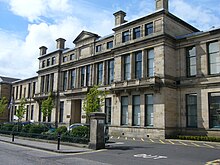Historic Scotland
 | |
| Formation | 1991 |
|---|---|
| Legal status | Executive Agency of the Scottish Government |
| Headquarters | Longmore House, Edinburgh |
Region served | Scotland |
Leadership | Ian Walford (acting) |
| Website | historic-scotland.gov.uk |
| Remarks | Appointment: 2009 |

Historic Scotland (Template:Lang-gd) was an executive agency of the Scottish Government, responsible for a number of the country's historic monuments.
Under the terms of a Bill of the Scottish Parliament published on 3 March 2014 Historic Scotland would be dissolved and its functions undertaken by a new executive non-departmental public body to be called Historic Environment Scotland, which would also take over the functions of the Royal Commission on the Ancient and Historical Monuments of Scotland.[1] This occurred on 1 October 2015.[2]
Role
As its website states:
Historic Scotland was created as an agency in 1991 and was attached to the Scottish Executive Education Department, which embraces all aspects of the cultural heritage, in May 1999. As part of the Scottish Government, Historic Scotland is directly accountable to the Scottish Ministers for safeguarding the nation's built heritage, and promoting its understanding and enjoyment.
Historic Scotland is a successor organisation to the Ancient Monuments Division of the Ministry of Works and the Scottish Development Department.
The agency's Framework Document sets out the responsibilities of the Scottish Ministers and the agency's Chief Executive.[3] Its Corporate Plan sets out its targets and performance against them.[4]
Historic Scotland's role has not been without controversy. In 2002, proposals to restore Castle Tioram in the West Highlands, by putting a roof back on, were blocked by Historic Scotland, which favoured stabilising it as a ruin. This position was supported in an extensive local Public Inquiry at which the arguments for both sides were heard.[5] It has been implied that this dispute has led to a review of the operations of the organisation.[6] Such disputes on the proper way to conserve a building are common, but are normally resolved within an academic context.
After widespread consultation, Historic Scotland published a comprehensive series of Scottish Historic Environment Policy papers, consolidated into a single volume in October 2008.[7]
Historic Scotland and the Glasgow School of Art's Digital Design Studio have formed the Centre for Digital Documentation and Visualization to promote the documentation and 3D representation of heritage objects, architecture and environments with laser scanning and 3D visualization software.[8]
Properties
Historic Scotland has direct responsibility for maintaining and running over 360 monuments in its care, about a quarter of which are manned and charge admission entry. These properties have additional features such as guidebooks, books and other resources. Since its inception it has increased the number of events run at its sites, most frequently designed to engage young people with history. Similarly, new museums and visitor centres have been opened, notably at Arbroath Abbey and Urquhart Castle. There is also a hospitality section, which makes some properties available for wedding receptions and other functions.
Notable properties include:
- Edinburgh Castle
- Stirling Castle
- Urquhart Castle
- Linlithgow Palace
- Caerlaverock Castle
- Skara Brae
- Jarlshof
Membership
Membership to Historic Scotland is promoted by the organisation, with benefits such as free entry to all their properties and over 400 events for the duration of the annual membership, as well as half price entry to properties in England (under the care of English Heritage), Wales (under the care of Cadw) and the Isle of Man (under the care of Manx National Heritage), becoming free in subsequent years. Lifetime memberships are also available, and all members receive a quarterly magazine 'Historic Scotland'.
Equivalent organisations
- Cadw (Wales)
- English Heritage
- Manx National Heritage
- Northern Ireland Environment Agency (formerly the Environment and Heritage Service)
See also
- List of Historic Scotland properties
- Listed buildings in Scotland
- Royal Commission on the Ancient and Historical Monuments of Scotland
- Scheduled monument
- Index of conservation articles
- Scottish Ten
References
- ^ "Historic Environment Scotland Bill". Scottish Parliament. Retrieved 6 July 2014.
- ^ "About Historic Environment Scotland". Retrieved 15 November 2015.
- ^ "Framework document 2012" (PDF). Historic Scotland. Retrieved 17 March 2013.
- ^ "Corporate plan" (PDF). Historic Scotland. Retrieved 17 March 2013.
- ^ "Inquiry Reports: Castle Tioram". Historic Scotland. Retrieved 17 March 2013.
- ^ "Historic Scotland criticised over ruin". The Scotsman. 12 December 2002. Retrieved 17 March 2013.
- ^ "Scottish Historic Environment Policy". Historic Scotland. Retrieved 17 March 2013.
- ^ "About the Scottish Ten". CDDV. Retrieved 17 March 2013.
